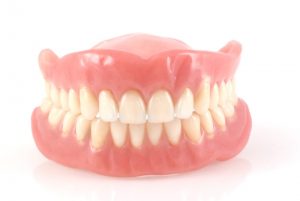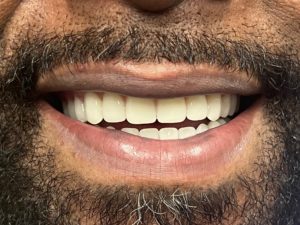
Losing a tooth can be a daunting experience, but the journey to regaining your confident smile doesn’t have to be a rocky one.
Immediate denture solutions offer a temporary fix that allows you to maintain your appearance and functionality while you heal. In this article, we’ll explore the world of immediate dentures, providing insights into their types, advantages, disadvantages, and the procedure itself. By the end, you’ll have a comprehensive understanding of whether this dental treatment is the right fit for you.
Key Takeaways
- Immediate dentures are temporary replacements for missing teeth, providing improved aesthetics and speech/chewing abilities.
- They require frequent adjustments due to changes in the mouth during healing, as well as additional factors such as construction time and surgical stents.
- Immediate dentures provide a temporary solution while permanent dentures offer enhanced durability with tailored fits post-healing.
Immediate Denture Explained
Immediate dentures are:
- Temporary dentures that are placed directly after tooth extraction
- They serve as a temporary tooth replacement solution while awaiting permanent complete dentures or all on four
- They protect gum tissue during the healing process following extractions
However, bear in mind that immediate dentures aren’t suitable for everyone, particularly following tooth extractions. The suitability of this treatment depends on specific oral problems, general health conditions, and the patient’s unique dental situation.
There are two main types of immediate dentures: complete and partial dentures, depending on the number of teeth being replaced. Complete dentures are used when all natural teeth have been extracted, while partial dentures are designed to fill gaps left by missing teeth, with the remaining natural teeth acting as support.
Types of Immediate Dentures
Complete dentures, also known as conventional denture or immediate dentures, are inserted directly after teeth extraction. Conversely, interim immediate dentures, which are a type of complete denture, are partial in nature and are inserted right after the teeth are extracted.
Under certain circumstances, like compromised or over-erupted teeth, a postponed fitting may be required as it could hinder the fitting of immediate dentures or false teeth. Deciding on the right type of immediate denture depends on the patient’s specific dental needs and the dentist’s recommendations.
When Immediate Dentures Are Recommended
Patients desiring to preserve a natural appearance during the healing phase often find immediate dentures an appealing option. They provide a temporary solution for patients who want to avoid appearing in public without teeth while they heal, allowing them to eat soft foods during the healing process.
Essentially, an immediate denture functions as a temporary remedy during the creation and fitting of a permanent denture.
Advantages of Immediate Dentures
Immediate dentures offer many benefits, such as preserving aesthetics and self-confidence, enhancing speech and improving chewing abilities.
They allow patients to maintain their appearance and self-confidence while providing support for early speech patterns and better chewing abilities, which facilitates adaptation and allows patients to return to their normal diet more quickly.
Aesthetics and Confidence
Immediate dentures have numerous aesthetic advantages, like maintaining a full set of teeth, instant smile restoration, and enhanced facial aesthetics. They provide a smooth transition to a more confident smile, ensuring that patients feel comfortable and at ease in social situations.
Furthermore, immediate dentures can assist in preserving self-confidence by providing a temporary tooth replacement solution that helps patients maintain their aesthetic and smile. The presence of natural teeth during the crafting of immediate dentures allows for a more accurate replication of the shape, color, and arrangement of the patient’s original teeth.
Speech and Chewing
Another advantage of immediate dentures is their ability to support early speech patterns and better chewing abilities. Immediate dentures provide stability, practice, and the bite and swallow technique to improve speech. This enables patients to adapt more easily to their new dentures and communicate effectively without significant disruptions to their daily lives.
In terms of chewing, immediate dentures can facilitate mastication by providing a reliable foundation for the jaw and enabling superior control of the jaw muscles. This allows patients to enjoy a variety of foods, including:
- soft foods
- crunchy foods
- chewy foods
- fruits and vegetables
- meats and proteins
Patients can gradually transition back to their normal diet as their mouth heals and they become more comfortable with their dentures.
Disadvantages of Immediate Dentures
While immediate dentures offer numerous benefits, there are also some drawbacks to consider. The main drawbacks of immediate dentures encompass higher costs and the necessity for adjustments due to an initially inaccurate fit and alterations in the mouth during healing.
Cost Factors
Immediate dentures can be more expensive than conventional dentures due to:
- Additional construction time
- Surgical stent
- Follow-up visits
- Temporary reline
- The need for a permanent reline or new denture after six months
It’s important to consider these additional expenses when evaluating the feasibility of immediate dentures for your dental needs.
The cost of the pre-extraction process is also contingent upon the type of denture being fabricated, the intricacy of the extraction, and the cost of the materials utilized. In general, immediate dentures are estimated to be approximately 25% more expensive than conventional cosmetic dentures.
Fit and Adjustments
Another disadvantage of immediate dentures is the need for multiple adjustments due to initial inaccurate fit and changes in the mouth during the healing process. The initial fit of immediate dentures may not be as snug as desired, necessitating adjustments on the day of delivery. Furthermore, an individual adjustment process is necessary, as proper fit is essential to avoid potential problems such as discomfort and difficulty speaking and chewing.
During the healing period, modifications and adjustments may be necessary to ensure an optimal fit. These may include trimming, grinding, and relining the denture. Regular visits to the dentist are necessary to ensure that the denture is fitting properly and to make any adjustments that may be required.
Immediate Denture Procedure
The immediate denture procedure entails pre-extraction steps like taking impressions and ordering the denture, succeeded by post-extraction care and adjustments.
This ensures that the denture is crafted to fit the patient’s mouth as closely as possible, considering the changes that occur during the healing process.
Pre-Extraction Process
The pre-extraction phase of immediate dentures demands the creation of the dentures before the tooth extraction. This allows the dentures to be inserted immediately post-extraction in order to protect the tissues and minimize bleeding. The process generally includes taking impressions of the patient’s mouth, ordering the immediate denture, and extracting teeth.
An impression of your mouth is taken while you still have your natural teeth. This is used to create an immediate denture. Your dentist will place denture teeth as close to the original position of your remaining teeth as possible. They will take into account the size and shape of your mouth following the extraction of a tooth when doing so.
Post-Extraction Care
After the extraction, post-extraction care involves adhering to the instructions provided by the dental professional, managing any discomfort, and attending follow-up visits for refitting and adjustments. It is recommended to keep immediate dentures in for a period of 48 hours after extraction.
As advised by the dental professional, post-extraction care should include managing pain, as well as attending follow-up visits for refitting and adjustments. These visits ensure that the denture is fitting properly and that any necessary modifications are made, such as trimming, grinding, and relining the denture.
Comparing Immediate and Permanent Dentures
To grasp the differences between immediate and permanent dentures, we should contrast their purpose, appearance, and fit.
Immediate dentures function as a provisional remedy during the healing period, whereas permanent dentures act as enduring tooth replacement solutions.
Temporary vs. Long-Term Solutions
Immediate dentures are intended as a temporary solution to be worn during the healing process, while permanent dentures are a long-term tooth replacement option. This means that immediate dentures are designed to be used for a shorter period of time, providing a convenient and rapid approach to replacing missing teeth during the healing process.
On the other hand, permanent dentures offer the following benefits:
- Enhanced durability
- Easier oral hygiene maintenance
- More stable and comfortable fit
- Tailored specifically to the patient’s mouth after the healing process is complete
Appearance and Fit
The primary distinction in appearance between immediate and permanent dentures is that immediate dentures are temporary, while permanent dentures are intended to be long-lasting. Immediate dentures are created prior to teeth extraction and are inserted immediately following extraction, whereas permanent dentures are fabricated after the gums have healed.
In terms of fit, permanent dentures are crafted to specifically fit the patient’s mouth, thus providing a more exact and comfortable fit in comparison to immediate dentures. This is due to the fact that immediate dentures are crafted with the current shape of the mouth in mind, while permanent dentures are crafted with the anticipated shape of the mouth post-healing.
Summary
In conclusion, immediate dentures offer a valuable temporary solution for those undergoing tooth extractions and in need of a temporary tooth replacement option. With their ability to maintain aesthetics, confidence, speech, and chewing abilities, they provide a viable option for many patients. However, it’s important to consider the disadvantages, such as higher costs and the need for adjustments, when deciding if immediate dentures are the right choice for you. By understanding the differences between immediate and permanent dentures, you can make an informed decision and take the first steps towards a confident, healthy smile.
Frequently Asked Questions
How long does an immediate denture last?
Immediate dentures are designed to be a temporary solution and typically last for 6 to 9 months until they can be replaced by a permanent denture. The time period may be shorter if less teeth were extracted.
Do immediate dentures look like real teeth?
Immediate dentures can be made in the color and material of your choice, making them look quite natural. However, they may not fit as perfectly as permanent dentures.
How painful are immediate dentures?
Immediate dentures are generally not more uncomfortable than the extractions themselves, and discomfort can be managed with anesthesia and pain medication. They act like a Band Aid bandage to help hold tissues together during healing.
What are the steps for an immediate denture?
An immediate denture is a process which begins with an impression of your mouth while your natural teeth are still intact. Following the extraction of teeth, your dentist will place denture teeth as close as possible to the original position of your remaining teeth and a wax try-in may also be done. On the day of delivery, your dentist will extract the necessary teeth and insert the immediate denture.
What are immediate dentures?
Immediate dentures provide a temporary tooth replacement solution after tooth extraction while awaiting permanent complete dentures.
Please select service, date and provider then click on the Find Appointments button.





